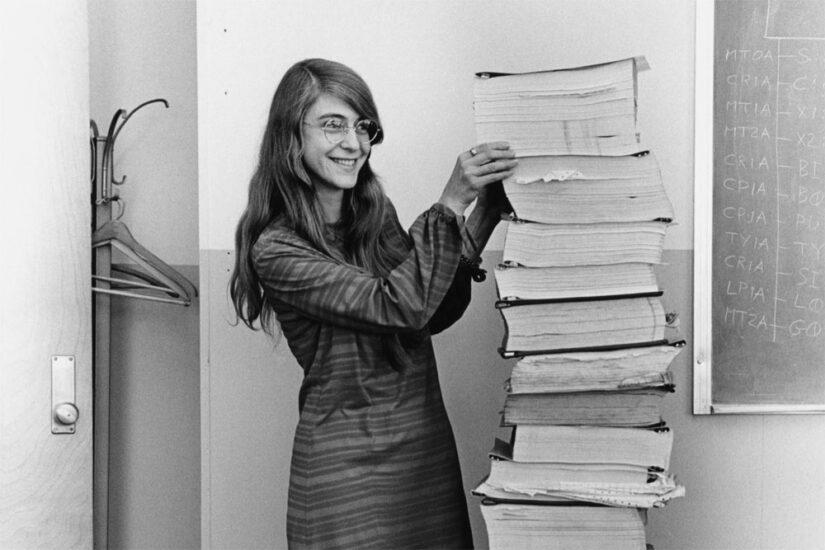Updated 2023
March 8th is International Women’s Day! In honor of the incredible scientists, engineers, and mathematicians who have changed the world, here are 4 famous women in STEM to motivate your child!
Margaret Hamilton, software engineer (1936 –)
Margaret Hamilton is a computer scientist and software engineer who was directly responsible for developing in-flight software used by astronauts during the famous Apollo moon missions. Hamilton began as a programmer and moved towards system designs, eventually leading the team responsible for creating Command Module software to assist with lunar landing.
During the famous Apollo 11 moon landing, the in-flight software Hamilton helped to develop warned the astronauts that something was wrong. The astronauts accidentally left a radar switch on without realizing it, causing the computer system to overload during the landing procedure. Hamilton’s priority alarm displays were designed to warn the astronauts in case of an emergency, and her software alerted them to the situation.
Hamilton (shown above) was famously photographed standing next to listings of the software she and her team produced for the Apollo project in 1969! In 2016, Margaret Hamilton received the Presidential Medal of Freedom for her contributions to STEM fields.
Sally Ride, astronaut (1936 – 2012)

Sally Ride was a physicist and astronaut who became the first American woman and known LGBTQ+ person to visit space in 1983. Ride earned a master’s degree and PhD in physics from Stanford University and was heavily invested in space research prior to working for NASA.
Ride applied to become an astronaut in 1978 and was one of only 35 people selected out of 8,000 applications. During press conferences, questions about Ride’s gender often came up. Despite this, Ride always claimed to see herself in one way only – as an astronaut.
In 1983, Sally Ride became the first woman in space as part of the Space Shuttle Challenger crew (the same shuttle that would suffer an infamous accident just three years later). Ride continued to work with NASA public-outreach programs throughout her life and passed away in 2012. Sally Ride was posthumously awarded the Presidential Medal of Freedom in 2013 and continues to be an inspiration for young minds everywhere.
Marie Maynard Daly, biochemist (1936 – 2003)
Photo: Archives of the Albert Einstein College of Medicine, Ted Burrows, photographer
Marie Maynard Daly made history in 1947 by becoming the first Black American woman in the United States to earn a doctoral degree (a PhD) in chemistry. Daly was inspired by her father’s interest in science, who himself had tried to pursue a career in chemistry, but was unable to finish due to financial struggles. Daly often stated that her intention was to continue her father’s legacy by majoring in chemistry herself.
Throughout her career, Daly studied the body’s cells, how proteins are constructed in the body, and how the body’s chemicals work to digest food. Her groundbreaking research helped to establish the link between high cholesterol and clogged arteries, as well as how diets can affect heart health and the circulatory system.
In 1988, Marie Maynard Daly established a scholarship fund to assist minority students majoring in chemistry or physics and named the program in honor of her father. Daly’s contributions to minority women in STEM help continue her legacy today.
Adriana C. Ocampo Uria, planetary geologist (1955 –)
Photo: nasa.gov
Adriana C. Ocampo Uria was born in Columbia and later emigrated to California, where she received her Master in Sciences. She later obtained her PhD in the Netherlands and has worked for NASA’s Jet Propulsion Laboratory, where she still serves as the science coordinator for planetary missions.
Incredibly, one of the primary theories about the extinction of dinosaurs is due to Ocampo’s research! Ocampo is credited as being the first to recognize a massive buried crater in Mexico, known as the Chicxulub crater. Ocampo discovered the crater using satellite imagery, and some scientists believe it marks the spot where a massive asteroid hit Earth millions of years ago – subsequently triggering a chain of events that led to the extinction of dinosaurs.
Want to learn more about famous women in STEM? Check out this article for more fascinating details about womens’ contribution to science and technology throughout history.
Are you looking to help your child learn to love STEM? Click here to find a STEM tutor near you.





